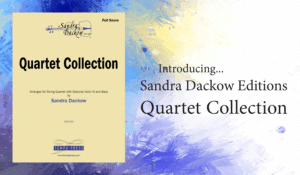
Midwest Clinic 2025
Wednesday 12/17Central Junior High Full Orchestra • 10:15am (W375E)40086 Dance of the Tumblers • Rimsky-Korsakov/Dackow Orchestra New Music Reading Session • 1:30pm (W183)40975 Symphony No. 12 in
Divinum Mysterium dates from the 11th century, and possibly before. It is a plainchant melody that first appeared in print in 1582 in the Finnish song book Piae Cantiones. Though associated with different texts throughout the centuries, it is perhaps best known as the tune for the hymn “Of the Father’s Love Begotten,” and is often associated with the Christmas season.
The tune itself, being a chant, has an irregular meter, which lends itself nicely to a more free-form and fantasia-like meditation. After a brief introduction, the tune itself appears with minimal embellishment or alteration in the first violins. It then passes in shorter sections amongst all the instruments of the orchestra, each of which adds its own ornamentation. A final iteration, with a much more chordal setting of the tune, closes out the piece.
All parts should play sweetly and gently throughout the piece, even when the dynamic grows more forceful near the end. All players should strive for a musical, reverent tone in their playing.
Be sure the first violin brings out the melody starting in measure 5, but let the second violins and violas have fun with their countermelody on the eighth notes.
Starting at measure 23, the melody passes from part to part; those with the melody are marked mezzo-piano, while the accompaniment is marked piano. Be sure each instrument brings out the melody when it’s their turn, and really let them play out their embellishments to the tune as they happen.
At measure 41, the second violins, violas, and celli should play as lushly as possible, and really milk this section for all the musicality they can muster. The crescendo in measure 48 should sound confident and assured, not bold or angry. Make a big decrescendo in 53, an even bigger crescendo in 54, and after the caesura, let the echo of the chord die away before continuing on to measure 55. Feel free to make a big deal of both the ritardando in measures 57-58, as well as the one from 61 to the end. Embrace the dissonances on the last chord, and let it fade away to nothing.
Jason W. Krug is a native of Indianapolis, Indiana. He holds a degree in music from the Massachusetts Institute of Technology.
Jason is a full-time freelance composer, arranger, clinician, and teacher. Since his first publication in 2006, he’s had over 400 compositions and arrangements accepted for handbells, piano, strings, organ, and choir. His works have been featured at numerous festivals and workshops in the United States and beyond.
In his spare time, Jason enjoys writing. He has spent several years working on a young adult fantasy series, The Sadonian Chronicles, and recently released his first non-fiction book, The General Theory of Creativity. He frequently participates in the National Novel Writing Month event in November.
Jason continues to live in Indianapolis with his wife Ellen and his sons Daniel and Malcolm. You can find him on the web at jasonwkrug.com.

Wednesday 12/17Central Junior High Full Orchestra • 10:15am (W375E)40086 Dance of the Tumblers • Rimsky-Korsakov/Dackow Orchestra New Music Reading Session • 1:30pm (W183)40975 Symphony No. 12 in

Acclaimed arranger Sandra Dackow brings her skills to the small ensemble with this collection of some of her best-loved arrangements. This Quartet Collection serves as

Thursday, March 21, 11:00am Ballroom D-E Vivace and ViBravo Orchestra Featured work: 1812 Overture Grade 3, String Orchestra, Peter Ilyich Tschaikowsky Arranged by Sandra Dackow

The holiday season is a time for celebrating with friends and family, and what better way to do so than through music? If you’re a
Be the first to know about new music, exciting news, deals and more!